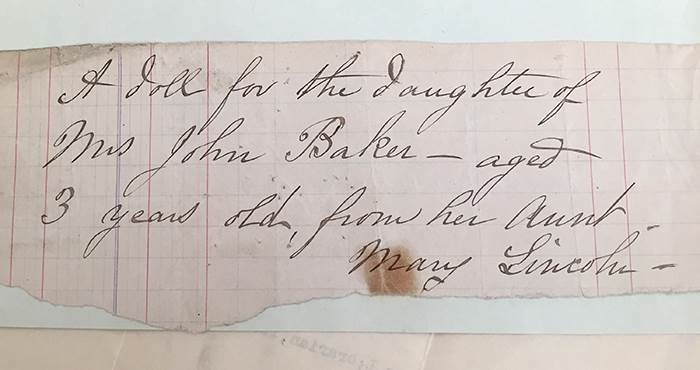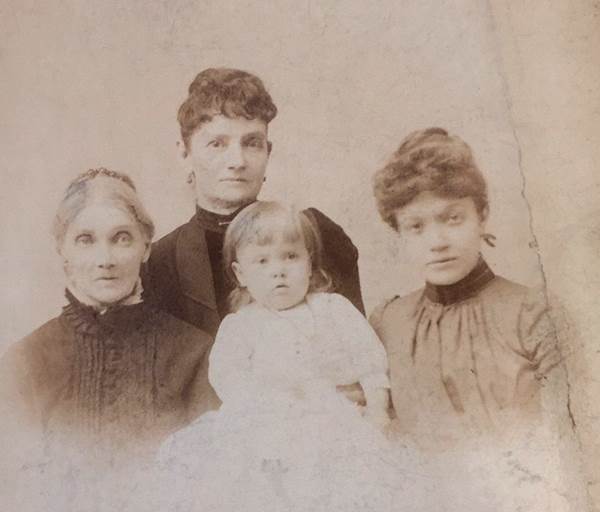By Christopher Schnell
A newly discovered note by Mary Lincoln, probably written in 1869 or 1870, connects the former first lady with her sister Frances Wallace’s family through the time-honored practice of gift-giving.
In a former post about a donation of papers, we looked at a new discovery, an 1839 letter from Mary Lincoln’s father, Robert Todd, to another daughter, Frances. The letter included the promise of wedding gifts to Frances and her soon-to-be spouse, William S. Wallace.
Now another note, also uncovered while processing this donation, shows Mary Lincoln giving gifts to her grandniece, Frances Wallace’s granddaughter.
Material signs of wealth, such as gifts purchased and mailed from afar, were important to Mary and typical for nineteenth-century white, middle- and upper-classes. These symbols not only conveyed status but also maintained family connections across distance. This was especially important for Mary Lincoln as she spent significant time in Europe during the 1860s and 1870s.
As a widow, Mary Lincoln was also dependent upon her extended family — especially the families of her Springfield-based sisters — for housing and financial and emotional support.
 “A doll for the daughter of Mrs John Baker — aged 3 years old, from her Aunt. Mary Lincoln.” (ALPLM)
“A doll for the daughter of Mrs John Baker — aged 3 years old, from her Aunt. Mary Lincoln.” (ALPLM)
Since the note is undated and Mary Lincoln didn’t name a recipient, it’s not immediately clear which of three grandnieces was meant to receive the gift. But I have looked at provenance and family lineage to identify the recipient and assign a rough date to the document.
The note says the doll was for the 3-year-old daughter of “Mrs John Baker,” referring to Mary J. Wallace Baker, Francis Wallace’s daughter and Mary Lincoln’s niece. Baker had three daughters. The eldest, Mary (again!), was born Sept. 13, 1866. She would marry Walter Patteson in 1887 and have several children. The longest lived, and one who remained in Springfield most of her life, was Florence Patteson (d. 1987). Florence donated the family papers in 1971.
Baker's other daughters, Mabel (b. 1873) and Florence (b. 1876), both died without direct descendants.
Since the note about the gift came to the ALPLM from the daughter of Mary Baker Patteson, I’m making a bit of a leap and concluding the doll was a gift to little Mary for her third birthday. That would mean Mary Lincoln wrote the note around Sept. 13, 1869.
The archival context also supports the provenance: Several of the other items in the donation indicate a direct line from Frances Todd Wallace to Mary J. Wallace Baker to Mary Baker Patteson – that is, from Mary Lincoln’s sister to niece to grandniece. In contrast, the donated papers do not include anything from the other two possible recipients of the doll, Patteson’s sisters Mabel Baker and Florence Baker.
 Mary Baker (future Mary Patteson) posing with a doll. (ALPLM)
Mary Baker (future Mary Patteson) posing with a doll. (ALPLM)
I so very much want this photo capturing young Mary Baker Patteson holding a doll to be this post’s surprise evidence. The photo was in Mary Lincoln’s family album donated by Florence Patteson in 1971. In the photo, young Mary proudly wears a fashionable cape and hat and holds a large china doll (whose bonnet rests to the side on the table). Is it the doll given to her by her great-aunt Mary Lincoln? That I can’t say for certain — I have no proof beyond these few circumstances.
We don’t know what sort of personal interactions, if any, Mary Lincoln had with her grandnieces. We only know that the elder Mary sent a doll. This was a gesture very much in keeping with Mary Lincoln’s material orientation, middle-class tastes, and apparent desire for positive family connection.
Mary Lincoln’s biographers have noted that late in life she drew strength from youthful members of her extended family, including sister Elizabeth Edwards’s grandson, Edward “Lewis” Baker. Lewis comforted Mary upon her return to Springfield after she had been institutionalized. Mary Lincoln also depended more practically on Elizabeth and Ninian Edwards by taking residency in their house on Aristocracy Hill during her last days.
Was Frances’s family in the same standing? Surprisingly, it may have the reverse, with Mary Lincoln lending support to Frances and her daughter Mary J. Wallace Baker after they suffered financial setbacks. When the Baker house burned down in 1875, Frances lost most of her apparel and jewelry, including several dresses given her by Mary Lincoln. A couple of years later, while in residence in Pau, France, Mary Lincoln spent a great deal of money to send Frances a trunk full of woolen items, winter wear for her family.
 Mary Lincoln’s sister Frances (left) with her descendants: daughter Mary J. Baker (rear), granddaughter Mary Patteson (right) and great-granddaughter Mary Patteson (who would later become Mary Bostick). (ALPLM)
Mary Lincoln’s sister Frances (left) with her descendants: daughter Mary J. Baker (rear), granddaughter Mary Patteson (right) and great-granddaughter Mary Patteson (who would later become Mary Bostick). (ALPLM)
This photo of four generations was taken around 1890. It includes Frances Wallace, her daughter, her granddaughter and her great-granddaughter, yet another Mary! Although we can’t fully know parental motivation in each generation, the fact that all three were named Mary suggests a closeness to “Aunt” Mary Lincoln.
Frances reminisced in later years that her eldest daughter was a favorite of Abraham Lincoln, who loved to visit the newborn baby in the months before his wedding to Mary. Perhaps the doll-gift years later was Mary Lincoln following her deceased husband’s model, building bonds with the next generation.
Chris Schnell is the manuscripts manager at the Abraham Lincoln Presidential Library and Museum.